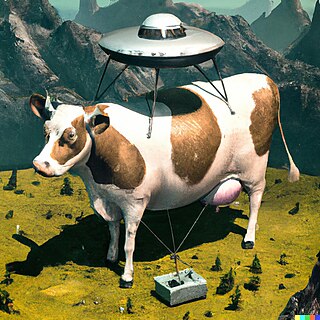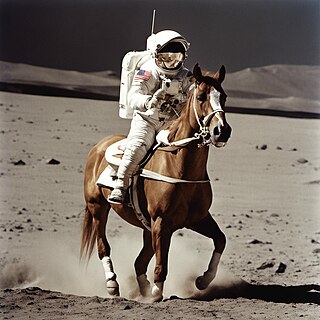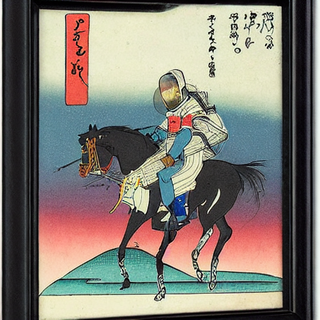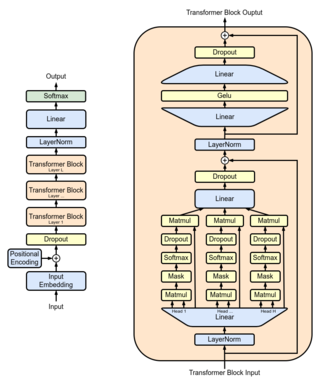Natural language generation (NLG) is a software process that produces natural language output. A widely-cited survey of NLG methods describes NLG as "the subfield of artificial intelligence and computational linguistics that is concerned with the construction of computer systems than can produce understandable texts in English or other human languages from some underlying non-linguistic representation of information".

Artificial intelligence art is any visual artwork created through the use of artificial intelligence (AI) programs.
80 Million Tiny Images is a dataset intended for training machine learning systems. It contains 79,302,017 32×32 pixel color images, scaled down from images extracted from the World Wide Web in 2008 using automated web search queries on a set of 75,062 non-abstract nouns derived from WordNet. The words in the search terms were then used as labels for the images. The researchers used seven web search resources for this purpose: Altavista, Ask.com, Flickr, Cydral, Google, Picsearch and Webshots.
Generative Pre-trained Transformer 3 (GPT-3) is a large language model released by OpenAI in 2020. Like its predecessor, GPT-2, it is a decoder-only transformer model of deep neural network, which supersedes recurrence- and convolution-based architectures with a technique known as "attention". This attention mechanism allows the model to selectively focus on segments of input text it predicts to be most relevant. It uses a 2048-tokens-long context and a hitherto-unprecedented 175 billion parameters, requiring 800GB of storage space, and has demonstrated strong "zero-shot" and "few-shot" learning abilities on many tasks.

Generative Pre-trained Transformer 2 (GPT-2) is a large language model by OpenAI and the second in their foundational series of GPT models. GPT-2 was pre-trained on BookCorpus, a dataset of over 7,000 self-published fiction books from various genres, and trained on a dataset of 8 million web pages. It was partially released in February 2019, followed by full release of the 1.5-billion-parameter model on November 5, 2019.

DALL·E, DALL·E 2, and DALL·E 3 are text-to-image models developed by OpenAI using deep learning methodologies to generate digital images from natural language descriptions, called "prompts".
Wu Dao is a multimodal artificial intelligence developed by the Beijing Academy of Artificial Intelligence (BAAI). Wu Dao 1.0 was first announced on January 11, 2021; an improved version, Wu Dao 2.0, was announced on May 31. It has been compared to GPT-3, and is built on a similar architecture; in comparison, GPT-3 has 175 billion parameters — variables and inputs within the machine learning model — while Wu Dao has 1.75 trillion parameters. Wu Dao was trained on 4.9 terabytes of images and texts, while GPT-3 was trained on 45 terabytes of text data. Yet, a growing body of work highlights the importance of increasing both data and parameters. The chairman of BAAI said that Wu Dao was an attempt to "create the biggest, most powerful AI model possible"; although direct comparisons between models based on parameter count do not directly correlate to quality. Wu Dao 2.0, was called "the biggest language A.I. system yet". It was interpreted by commenters as an attempt to "compete with the United States".. Notably, the type of architecture used for Wu Dao 2.0 is a mixture-of-experts (MoE) model, unlike GPT-3, which is a "dense" model: while MoE models require much less computational power to train than dense models with the same numbers of parameters, trillion-parameter MoE models have shown comparable performance to models that are hundreds of times smaller.
Prompt engineering is the process of structuring text that can be interpreted and understood by a generative AI model. A prompt is natural language text describing the task that an AI should perform.

You.com is a personalization-focused search engine. It allows its users to upvote, downvote, or block results. You.com provides additional products, including a chatbot called YouChat, an AI writing tool called YouWrite, and an AI-image generator called YouImagine, which utilizes AI models Stable Diffusion and OpenJourney.
Hugging Face, Inc. is a French-American company that develops tools for building applications using machine learning, based in New York City. It is most notable for its transformers library built for natural language processing applications and its platform that allows users to share machine learning models and datasets and showcase their work.

Stable Diffusion is a deep learning, text-to-image model released in 2022 based on diffusion techniques. It is considered to be a part of the ongoing AI spring.

A text-to-image model is a machine learning model which takes an input natural language description and produces an image matching that description.

DreamBooth is a deep learning generation model used to personalize existing text-to-image models by fine-tuning. It was developed by researchers from Google Research and Boston University in 2022. Originally developed using Google's own Imagen text-to-image model, DreamBooth implementations can be applied to other text-to-image models, where it can allow the model to generate more fine-tuned and personalized outputs after training on three to five images of a subject.

ChatGPT is a chatbot developed by OpenAI and launched on November 30, 2022. Based on a large language model, it enables users to refine and steer a conversation towards a desired length, format, style, level of detail, and language. Successive prompts and replies, known as prompt engineering, are considered at each conversation stage as a context.

In the field of artificial intelligence (AI), a hallucination or artificial hallucination is a response generated by an AI which contains false or misleading information presented as fact.

Generative pre-trained transformers (GPT) are a type of large language model (LLM) and a prominent framework for generative artificial intelligence. They are artificial neural networks that are used in natural language processing tasks. GPTs are based on the transformer architecture, pre-trained on large data sets of unlabelled text, and able to generate novel human-like content. As of 2023, most LLMs have these characteristics and are sometimes referred to broadly as GPTs.
The Pile is an 886.03 GB diverse, open-source dataset of English text created as a training dataset for large language models (LLMs). It was constructed by EleutherAI in 2020 and publicly released on December 31 of that year. It is composed of 22 smaller datasets, including 14 new ones.

Generative artificial intelligence is artificial intelligence capable of generating text, images, or other media, using generative models. Generative AI models learn the patterns and structure of their input training data and then generate new data that has similar characteristics.
LLaMA is a family of large language models (LLMs), released by Meta AI starting in February 2023.
In the 2020s, the rapid increase in the capabilities of deep learning-based generative artificial intelligence models, including text-to-image models such as Stable Diffusion and large language models such as ChatGPT, posed questions of how copyright law applies to the training and use of such models. Because there is limited existing case law, experts consider this area to be fraught with uncertainty.













